Page 17 of 39
There will also be one power lead
for each switch found as a blunt-cut
and sealed wire located to the right
of the glove box door and just above
the passenger side kick panel.
You may need to pull down the
auxiliary cords to access them.
Refer to theFuseschapter of your Owner’s Manual for information on
fuse and relay locations. See your authorized dealer for service.
Additional pass through circuits that run through the dash panel and
under the hood, are located in the same location.
The relays are coded as follows:
Switch Circuit number Wire color Fuse
AUX 1 CAC05 Yellow 30A
AUX 2 CAC06 Green with
Brown Trace30A
AUX 3 CAC07 Violet with
Green Trace15A
AUX 4 CAC08 Brown 10 A
i
Driving
16
2013 F-150(f12)
Supplement, 1st Printing
USA(fus)
Page 18 of 39
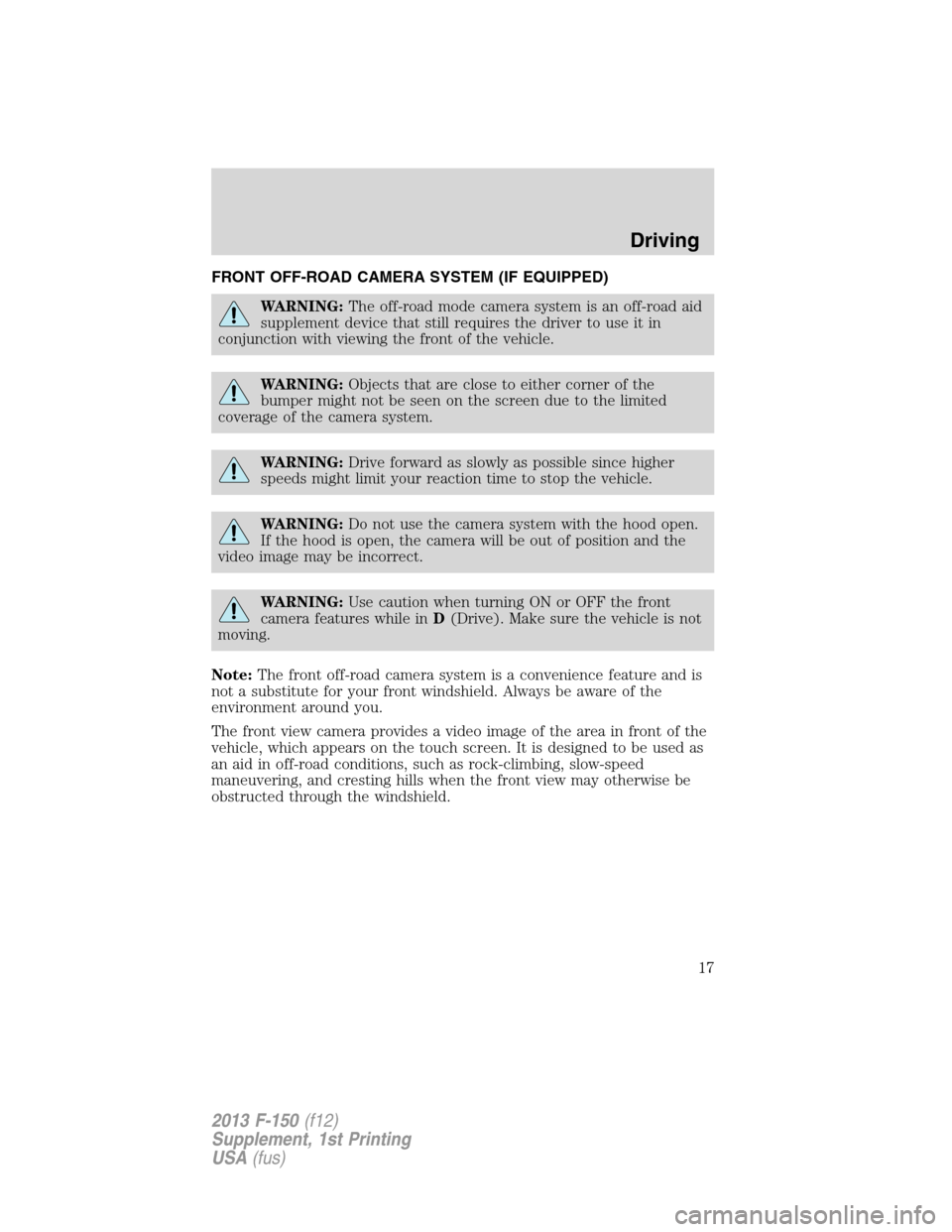
FRONT OFF-ROAD CAMERA SYSTEM (IF EQUIPPED)
WARNING:The off-road mode camera system is an off-road aid
supplement device that still requires the driver to use it in
conjunction with viewing the front of the vehicle.
WARNING:Objects that are close to either corner of the
bumper might not be seen on the screen due to the limited
coverage of the camera system.
WARNING:Drive forward as slowly as possible since higher
speeds might limit your reaction time to stop the vehicle.
WARNING:Do not use the camera system with the hood open.
If the hood is open, the camera will be out of position and the
video image may be incorrect.
WARNING:Use caution when turning ON or OFF the front
camera features while inD(Drive). Make sure the vehicle is not
moving.
Note:The front off-road camera system is a convenience feature and is
not a substitute for your front windshield. Always be aware of the
environment around you.
The front view camera provides a video image of the area in front of the
vehicle, which appears on the touch screen. It is designed to be used as
an aid in off-road conditions, such as rock-climbing, slow-speed
maneuvering, and cresting hills when the front view may otherwise be
obstructed through the windshield.
Driving
17
2013 F-150(f12)
Supplement, 1st Printing
USA(fus)
Page 19 of 39
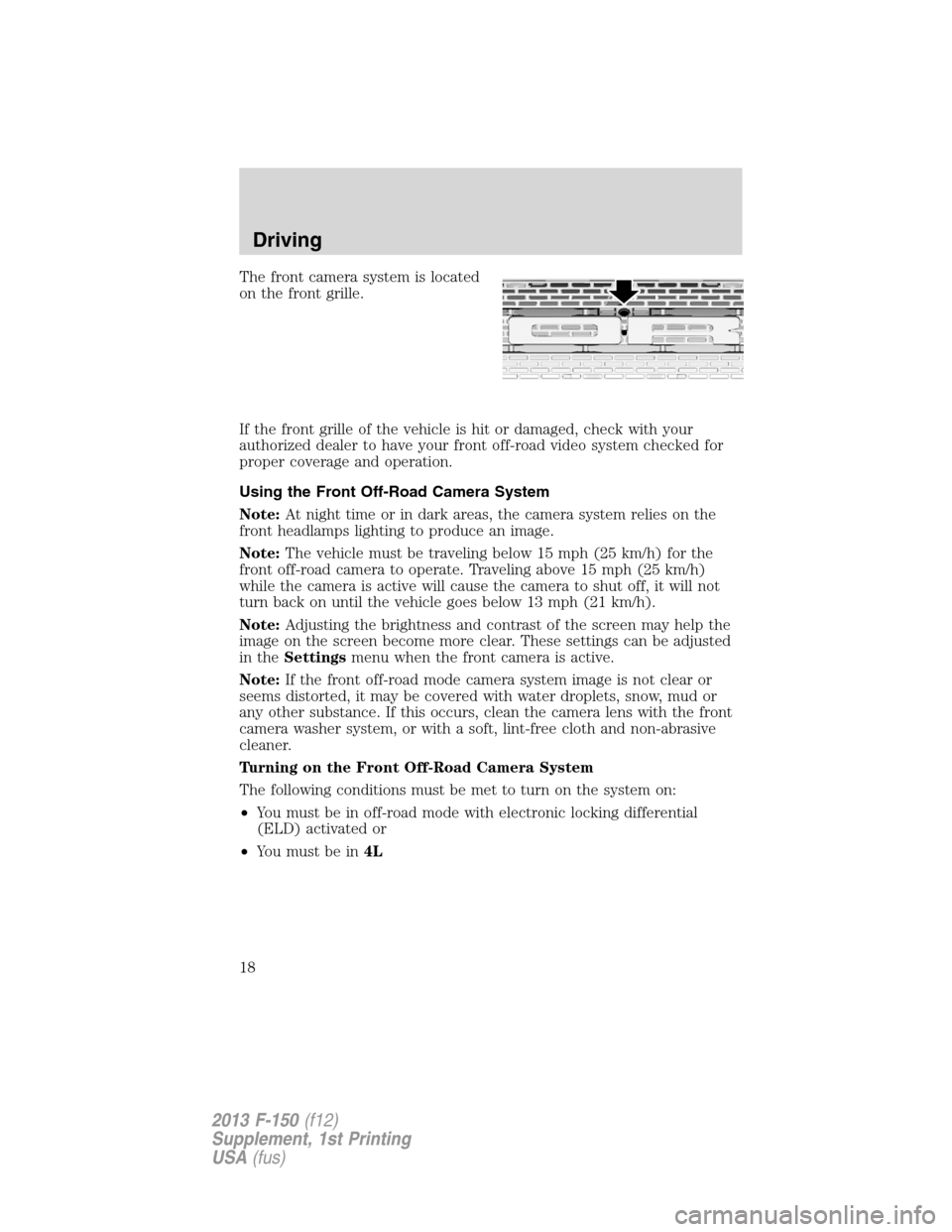
The front camera system is located
on the front grille.
If the front grille of the vehicle is hit or damaged, check with your
authorized dealer to have your front off-road video system checked for
proper coverage and operation.
Using the Front Off-Road Camera System
Note:At night time or in dark areas, the camera system relies on the
front headlamps lighting to produce an image.
Note:The vehicle must be traveling below 15 mph (25 km/h) for the
front off-road camera to operate. Traveling above 15 mph (25 km/h)
while the camera is active will cause the camera to shut off, it will not
turn back on until the vehicle goes below 13 mph (21 km/h).
Note:Adjusting the brightness and contrast of the screen may help the
image on the screen become more clear. These settings can be adjusted
in theSettingsmenu when the front camera is active.
Note:If the front off-road mode camera system image is not clear or
seems distorted, it may be covered with water droplets, snow, mud or
any other substance. If this occurs, clean the camera lens with the front
camera washer system, or with a soft, lint-free cloth and non-abrasive
cleaner.
Turning on the Front Off-Road Camera System
The following conditions must be met to turn on the system on:
•You must be in off-road mode with electronic locking differential
(ELD) activated or
•You must be in4L
Driving
18
2013 F-150(f12)
Supplement, 1st Printing
USA(fus)
Page 20 of 39
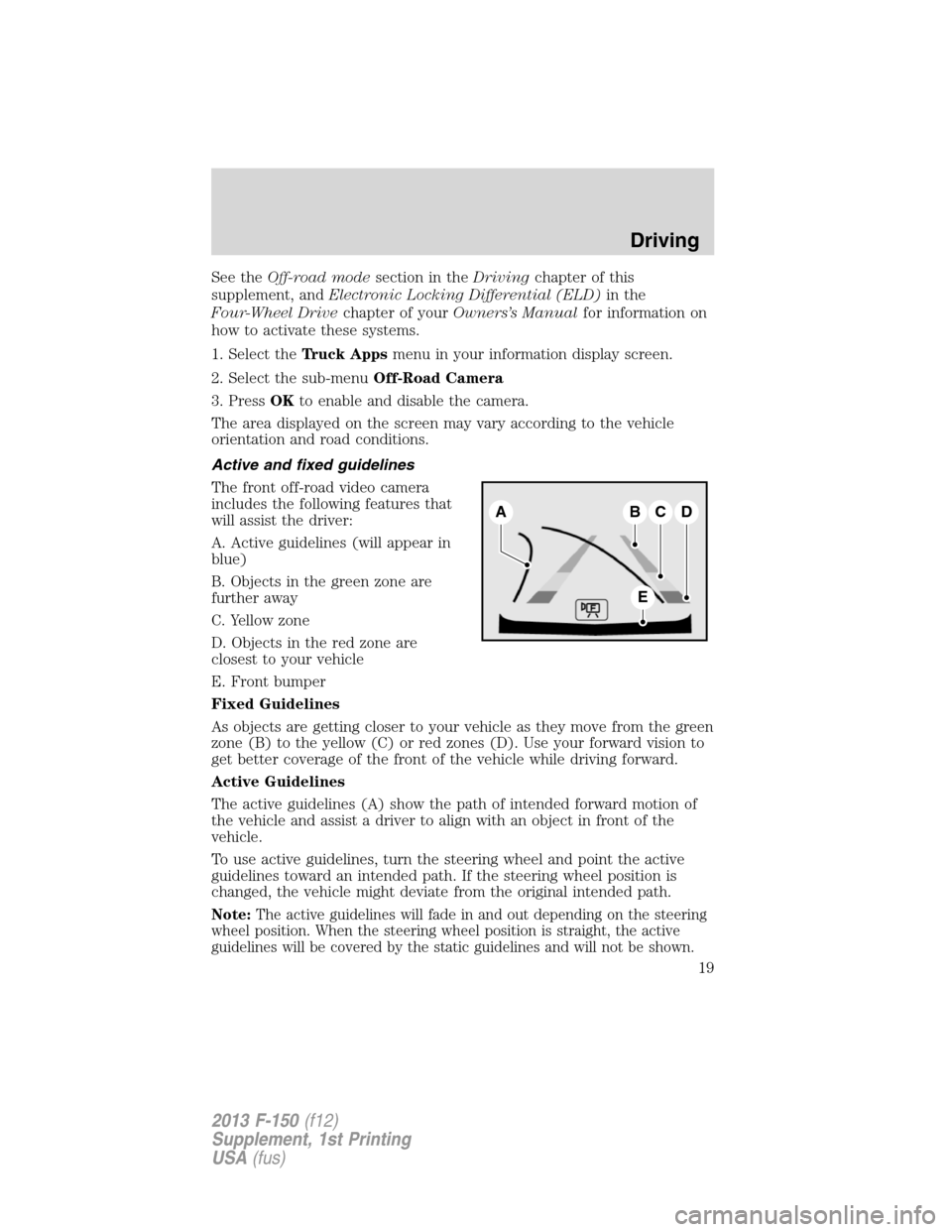
See theOff-road modesection in theDrivingchapter of this
supplement, andElectronic Locking Differential (ELD)in the
Four-Wheel Drivechapter of yourOwners’s Manualfor information on
how to activate these systems.
1. Select theTruck Appsmenu in your information display screen.
2. Select the sub-menuOff-Road Camera
3. PressOKto enable and disable the camera.
The area displayed on the screen may vary according to the vehicle
orientation and road conditions.
Active and fixed guidelines
The front off-road video camera
includes the following features that
will assist the driver:
A. Active guidelines (will appear in
blue)
B. Objects in the green zone are
further away
C. Yellow zone
D. Objects in the red zone are
closest to your vehicle
E. Front bumper
Fixed Guidelines
As objects are getting closer to your vehicle as they move from the green
zone (B) to the yellow (C) or red zones (D). Use your forward vision to
get better coverage of the front of the vehicle while driving forward.
Active Guidelines
The active guidelines (A) show the path of intended forward motion of
the vehicle and assist a driver to align with an object in front of the
vehicle.
To use active guidelines, turn the steering wheel and point the active
guidelines toward an intended path. If the steering wheel position is
changed, the vehicle might deviate from the original intended path.
Note:The active guidelines will fade in and out depending on the steering
wheel position. When the steering wheel position is straight, the active
guidelines will be covered by the static guidelines and will not be shown.
B
E
CDA
Driving
19
2013 F-150(f12)
Supplement, 1st Printing
USA(fus)
Page 21 of 39
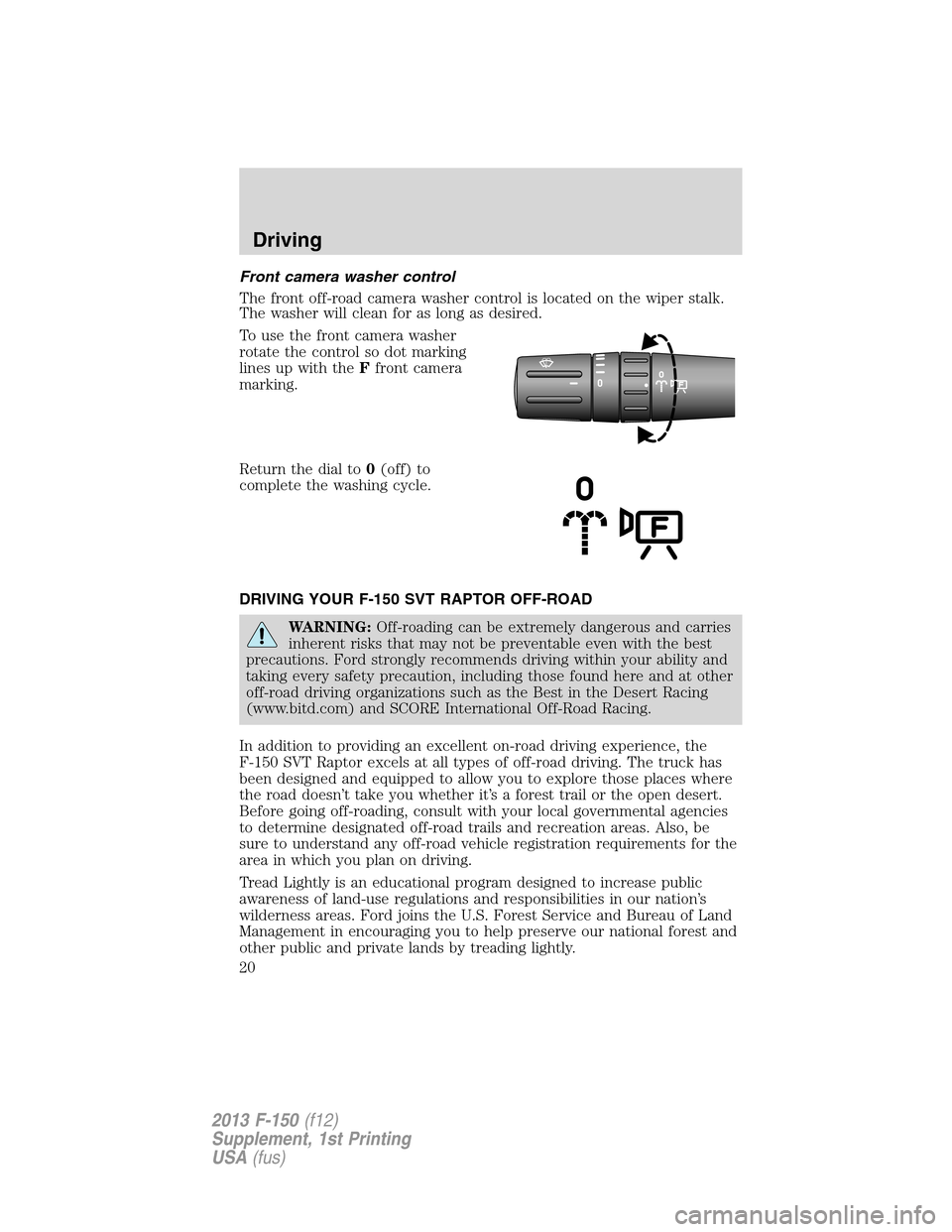
Front camera washer control
The front off-road camera washer control is located on the wiper stalk.
The washer will clean for as long as desired.
To use the front camera washer
rotate the control so dot marking
lines up with theFfront camera
marking.
Return the dial to0(off) to
complete the washing cycle.
DRIVING YOUR F-150 SVT RAPTOR OFF-ROAD
WARNING:Off-roading can be extremely dangerous and carries
inherent risks that may not be preventable even with the best
precautions. Ford strongly recommends driving within your ability and
taking every safety precaution, including those found here and at other
off-road driving organizations such as the Best in the Desert Racing
(www.bitd.com) and SCORE International Off-Road Racing.
In addition to providing an excellent on-road driving experience, the
F-150 SVT Raptor excels at all types of off-road driving. The truck has
been designed and equipped to allow you to explore those places where
the road doesn’t take you whether it’s a forest trail or the open desert.
Before going off-roading, consult with your local governmental agencies
to determine designated off-road trails and recreation areas. Also, be
sure to understand any off-road vehicle registration requirements for the
area in which you plan on driving.
Tread Lightly is an educational program designed to increase public
awareness of land-use regulations and responsibilities in our nation’s
wilderness areas. Ford joins the U.S. Forest Service and Bureau of Land
Management in encouraging you to help preserve our national forest and
other public and private lands by treading lightly.
Driving
20
2013 F-150(f12)
Supplement, 1st Printing
USA(fus)
Page 22 of 39
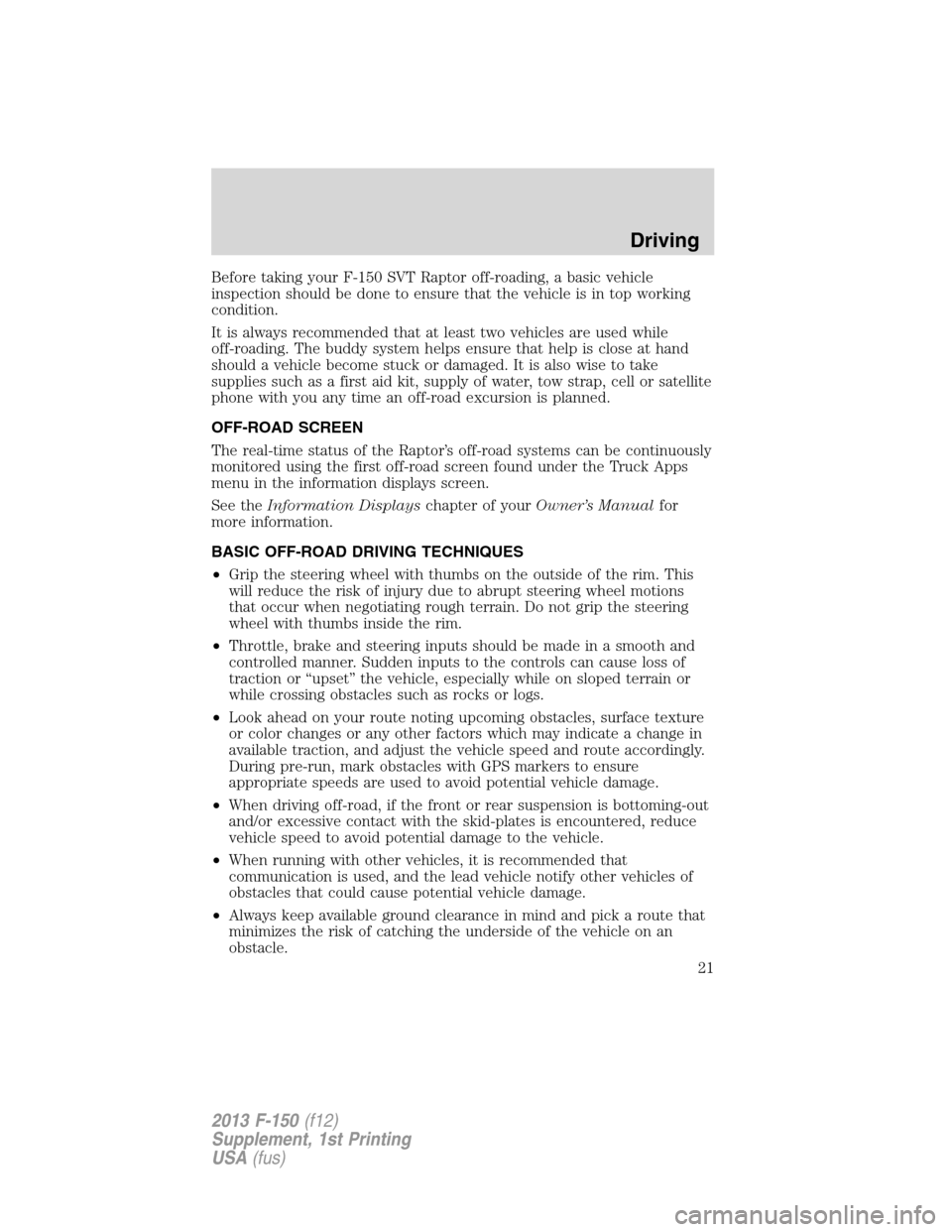
Before taking your F-150 SVT Raptor off-roading, a basic vehicle
inspection should be done to ensure that the vehicle is in top working
condition.
It is always recommended that at least two vehicles are used while
off-roading. The buddy system helps ensure that help is close at hand
should a vehicle become stuck or damaged. It is also wise to take
supplies such as a first aid kit, supply of water, tow strap, cell or satellite
phone with you any time an off-road excursion is planned.
OFF-ROAD SCREEN
The real-time status of the Raptor’s off-road systems can be continuously
monitored using the first off-road screen found under the Truck Apps
menu in the information displays screen.
See theInformation Displayschapter of yourOwner’s Manualfor
more information.
BASIC OFF-ROAD DRIVING TECHNIQUES
•Grip the steering wheel with thumbs on the outside of the rim. This
will reduce the risk of injury due to abrupt steering wheel motions
that occur when negotiating rough terrain. Do not grip the steering
wheel with thumbs inside the rim.
•Throttle, brake and steering inputs should be made in a smooth and
controlled manner. Sudden inputs to the controls can cause loss of
traction or “upset” the vehicle, especially while on sloped terrain or
while crossing obstacles such as rocks or logs.
•Look ahead on your route noting upcoming obstacles, surface texture
or color changes or any other factors which may indicate a change in
available traction, and adjust the vehicle speed and route accordingly.
During pre-run, mark obstacles with GPS markers to ensure
appropriate speeds are used to avoid potential vehicle damage.
•When driving off-road, if the front or rear suspension is bottoming-out
and/or excessive contact with the skid-plates is encountered, reduce
vehicle speed to avoid potential damage to the vehicle.
•When running with other vehicles, it is recommended that
communication is used, and the lead vehicle notify other vehicles of
obstacles that could cause potential vehicle damage.
•Always keep available ground clearance in mind and pick a route that
minimizes the risk of catching the underside of the vehicle on an
obstacle.
Driving
21
2013 F-150(f12)
Supplement, 1st Printing
USA(fus)
Page 23 of 39
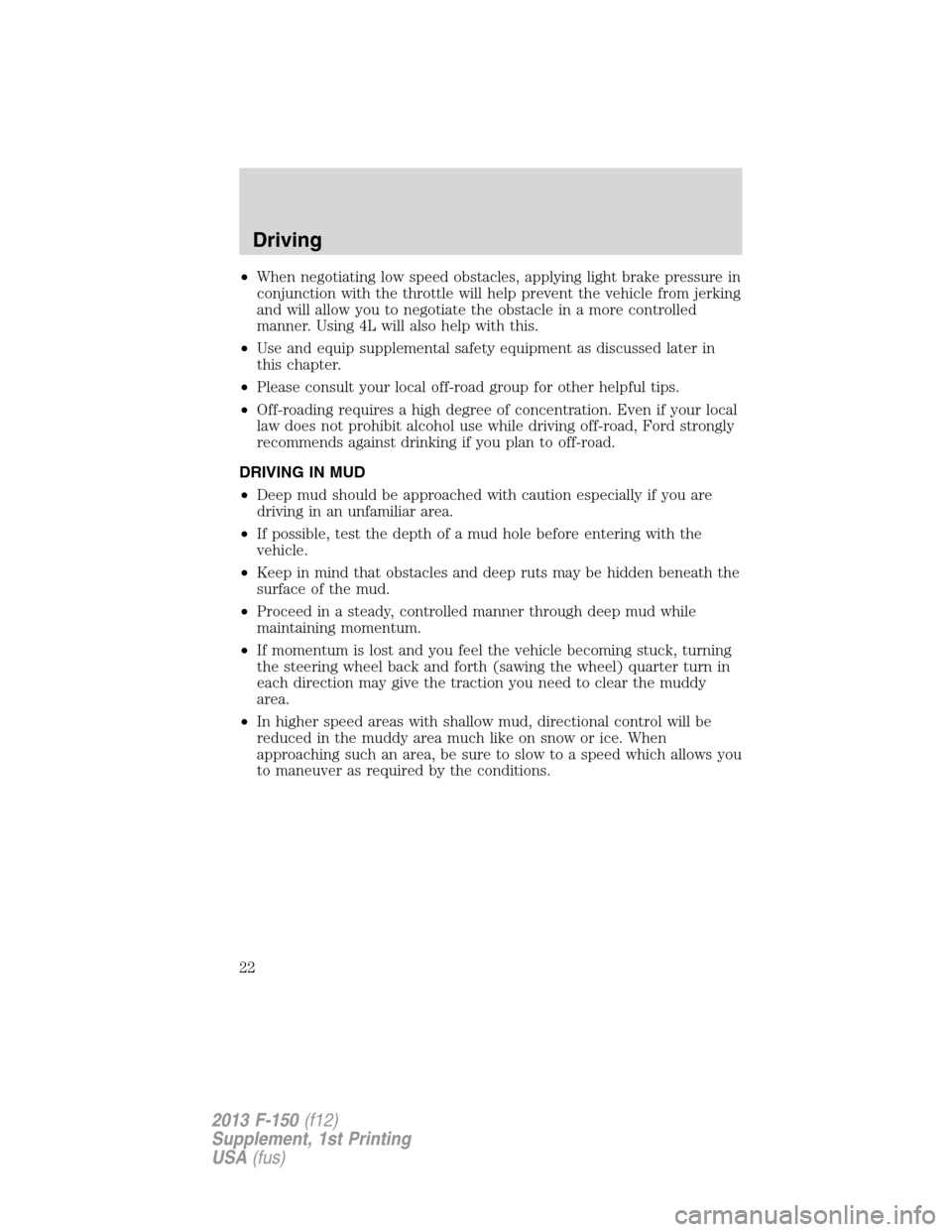
•When negotiating low speed obstacles, applying light brake pressure in
conjunction with the throttle will help prevent the vehicle from jerking
and will allow you to negotiate the obstacle in a more controlled
manner. Using 4L will also help with this.
•Use and equip supplemental safety equipment as discussed later in
this chapter.
•Please consult your local off-road group for other helpful tips.
•Off-roading requires a high degree of concentration. Even if your local
law does not prohibit alcohol use while driving off-road, Ford strongly
recommends against drinking if you plan to off-road.
DRIVING IN MUD
•Deep mud should be approached with caution especially if you are
driving in an unfamiliar area.
•If possible, test the depth of a mud hole before entering with the
vehicle.
•Keep in mind that obstacles and deep ruts may be hidden beneath the
surface of the mud.
•Proceed in a steady, controlled manner through deep mud while
maintaining momentum.
•If momentum is lost and you feel the vehicle becoming stuck, turning
the steering wheel back and forth (sawing the wheel) quarter turn in
each direction may give the traction you need to clear the muddy
area.
•In higher speed areas with shallow mud, directional control will be
reduced in the muddy area much like on snow or ice. When
approaching such an area, be sure to slow to a speed which allows you
to maneuver as required by the conditions.
Driving
22
2013 F-150(f12)
Supplement, 1st Printing
USA(fus)
Page 24 of 39
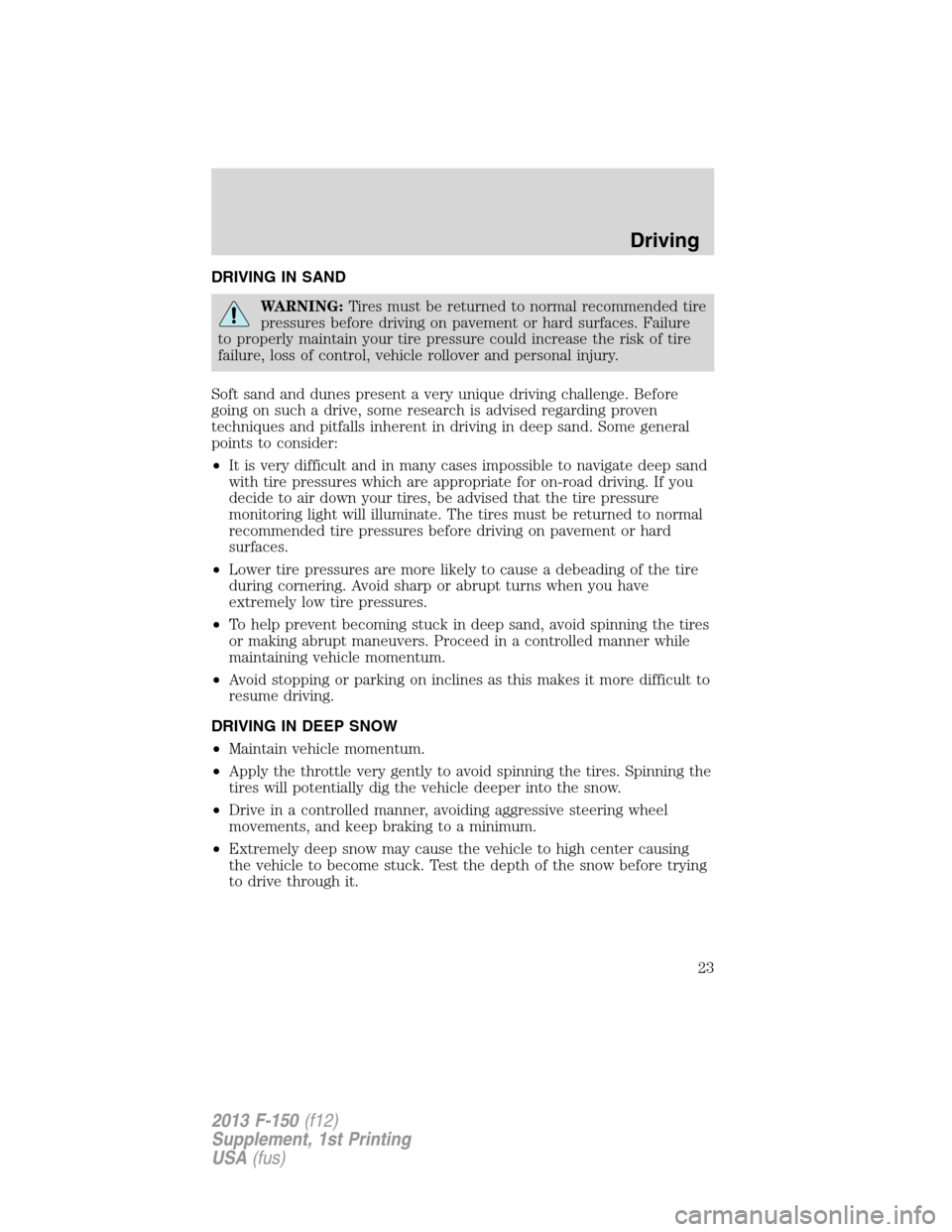
DRIVING IN SAND
WARNING:Tires must be returned to normal recommended tire
pressures before driving on pavement or hard surfaces. Failure
to properly maintain your tire pressure could increase the risk of tire
failure, loss of control, vehicle rollover and personal injury.
Soft sand and dunes present a very unique driving challenge. Before
going on such a drive, some research is advised regarding proven
techniques and pitfalls inherent in driving in deep sand. Some general
points to consider:
•It is very difficult and in many cases impossible to navigate deep sand
with tire pressures which are appropriate for on-road driving. If you
decide to air down your tires, be advised that the tire pressure
monitoring light will illuminate. The tires must be returned to normal
recommended tire pressures before driving on pavement or hard
surfaces.
•Lower tire pressures are more likely to cause a debeading of the tire
during cornering. Avoid sharp or abrupt turns when you have
extremely low tire pressures.
•To help prevent becoming stuck in deep sand, avoid spinning the tires
or making abrupt maneuvers. Proceed in a controlled manner while
maintaining vehicle momentum.
•Avoid stopping or parking on inclines as this makes it more difficult to
resume driving.
DRIVING IN DEEP SNOW
•Maintain vehicle momentum.
•Apply the throttle very gently to avoid spinning the tires. Spinning the
tires will potentially dig the vehicle deeper into the snow.
•Drive in a controlled manner, avoiding aggressive steering wheel
movements, and keep braking to a minimum.
•Extremely deep snow may cause the vehicle to high center causing
the vehicle to become stuck. Test the depth of the snow before trying
to drive through it.
Driving
23
2013 F-150(f12)
Supplement, 1st Printing
USA(fus)